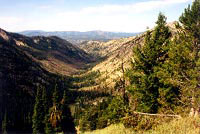Remember that old line that tells you to beware of getting what you wished for? The Bush administration and the timber industry may be on the verge of providing another illustration.
Even with a federal judge on their side.

The roadless travails.
Photo: U.S. Forest Service.
The administration wished to get rid of the National Forest Roadless Rule, both because Bill Clinton promulgated it and because the industry wanted to get rid of it. The industry wanted to get rid of it because Clinton promulgated it, because it would ban road-building and logging on more than 58 million acres of national forestland, but largely because … well, that’s complicated; we’ll get to it later.
So when the state of Idaho and the Boise Cascade timber company challenged the Rule in federal court, the U.S. Justice Department barely went through the motions of defending it. No wonder that U.S. District Judge Edward Lodge sided with the plaintiffs and issued a preliminary injunction against the Rule two days before it would have taken effect.
Lodge cited the Bush administration’s “own admission” that officials “share plaintiffs concerns about the potential for irreparable harm in the long-term,” under the Rule. Obviously pleased, the administration vacillated about whether to appeal. The environmental groups that have “intervenor” status did not, and expressed confidence that they would prevail.
For the moment, the judge has gotten the administration off the hook. Unless and until an appellate court reinstates the Rule, it won’t have to go ahead with its earlier, reluctant, agreement to let the plan take effect, but to amend it.
All these machinations support the contention of some environmentalists that the proposed amendments were a sham — a pretext for gutting the Rule while appearing to preserve it. According to the U.S. Agriculture Department, the amendments would allow it to give forests more protection from fire and insects, and “[work] together with states and communities,” two policies that in the past have been employed as excuses to give chain saws unlimited access to the woods.
But consider: Amending the Rule was not what the administration really wanted to do. And therefore, what it eventually proposes may not be what it really wants to propose. The reason? Plain and simple politics.

Roadless and fancy-free.
Photo: U.S. Forest Service.
Like its predecessors, this administration polls, and no doubt its private polls are consistent with the public survey by the Los Angeles Times, which showed a healthy 58-percent majority supporting the Roadless Rule, with majorities even in the Rocky Mountain West.
So the administration blinked. And in the words of Michael Francis of the Wilderness Society “maybe we can make them blink again.” With that majority, maybe he and his allies can. After all, the pro-Rule forces overwhelmed their opponents at public hearings during the initial Rule-making process.
Meanwhile, the Bushies have handed the Greenies a wonderful recruitment mechanism. The administration can’t just amend the Rule by fiat. It has to go through a process, including public comment, maybe even public hearings. These hearings could be great TV, but more likely for the Sierra Club than for Boise Cascade.
Or, if Lodge’s opinion is upheld, for Earth First!, Cascadia Alive, Julia Butterfly, and others inclined to lie down in front of bulldozers. The first road project in a Roadless Area is all but certain to be the scene of what left-of-centrists love to call “a direct action,” perhaps a rather popular one. Instead of muttering about “crazy kids,” Mr. Mythical Average American sitting in his suburban den is likely to say, “you know, Ethel, these kids have a point; let’s send ’em a check.”
So even with the Rule suspended, don’t expect much logging in the areas it was designed to protect.

Chip in, Dale!
Photo: U.S. Forest Service.
Adding to the administration’s woes, there is reason to believe that the man it has appointed chief of the U.S. Forest Service, Dale Bosworth, likes the Rule. He has praised it in the past. And on his first post-appointment visit to Washington, according to reliable sources, he met with environmentalists who told him they would “unleash a holy jihad” (the words of one irreverent source, not a participant), should he seek to scuttle the Rule. Few career bureaucrats like to start a new job with a big fight.
So why is the industry still fighting so hard, especially when there really isn’t all that much commercial timber in the protected areas? Plain and not-so-simple politics, that’s why. First, they still hate Clinton. And it’s a convenient diversion. Mills are closing all over the Interior West, not because of forest rules but because of technological advances and consolidation in this global age. How convenient to be able to tell the angry residents of a (former) mill town that their troubles were all caused by Bill Clinton and those nasty environmentalists.
Besides, the industry long ago made common cause with the Inland West’s conservative politicians, who long ago decided not to compromise on forestry issues. Through their fervor, they effectively created the national constituency that conceived and enacted the roadless Rule. No one likes to admit defeat, especially the defeated.


